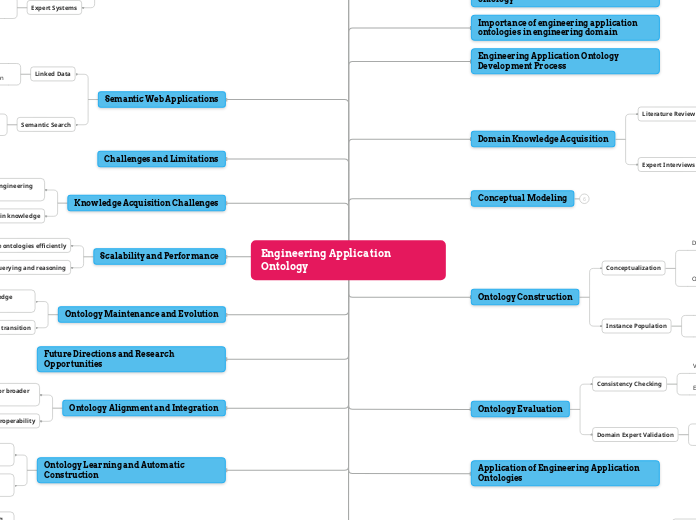Engineering Application Ontology
Introduction
Definition of an engineering application ontology
Importance of engineering application ontologies in engineering domain
Engineering Application Ontology Development Process
Domain Knowledge Acquisition
Literature Review
Gathering relevant engineering literature
Identifying key concepts and relationships
Expert Interviews
Consulting with domain experts
Extracting knowledge and insights
Conceptual Modeling
Ontology Construction
Conceptualization
Defining classes
properties
and relationships
Organizing concepts in a hierarchical structure
Instance Population
Creating instances of concepts
Assigning appropriate values to properties
Ontology Evaluation
Consistency Checking
Verifying logical consistency of the ontology
Ensuring absence of contradictions and conflicts
Domain Expert Validation
Presenting the ontology to domain experts for evaluation
Incorporating their feedback and suggestions
Application of Engineering Application Ontologies
Knowledge Representation and Sharing
Capturing Engineering Knowledge
Storing engineering knowledge in a structured format
Enabling easy retrieval and reuse of knowledge
Interoperability and Integration
Facilitating integration of diverse engineering systems and tools
Enabling seamless data exchange and interoperability
Decision Support Systems
Reasoning and Inference
Applying logical reasoning to infer new knowledge
Supporting decision-making processes
Expert Systems
Developing intelligent systems based on the ontologies
Providing expert-level insights and recommendations
Semantic Web Applications
Linked Data
Enabling linking and integration of engineering data on the web
Facilitating discovery and navigation of related information
Semantic Search
Enhancing search capabilities with semantic annotations
Improving precision and relevance of search results
Challenges and Limitations
Knowledge Acquisition Challenges
Accessing and organizing large amounts of engineering knowledge
Dealing with evolving and dynamic domain knowledge
Scalability and Performance
Handling large-scale ontologies efficiently
Optimizing ontology querying and reasoning
Ontology Maintenance and Evolution
Updating and revising ontologies as new knowledge emerges
Ensuring backward compatibility and smooth transition
Future Directions and Research Opportunities
Ontology Alignment and Integration
Integrating multiple engineering ontologies for broader coverage
Aligning ontologies to improve interoperability
Ontology Learning and Automatic Construction
Developing techniques to automatically construct ontologies from unstructured data
Leveraging machine learning and natural language processing for ontology development
Ontology Visualization and User Interfaces
Creating intuitive interfaces for browsing and exploring ontologies
Visualizing ontologies to enhance understanding and usability
